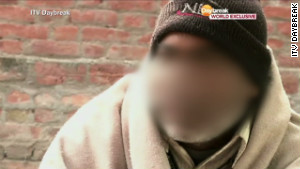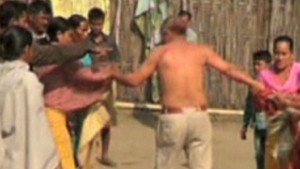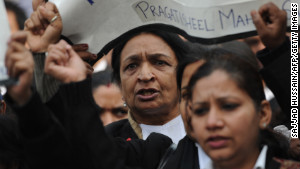Jhajjar, India (CNN) -- One-month-old baby girl Khushi, which means "happiness" in Hindi, would not have been alive had her mother, Sumanjeet, given in to pressure from some relatives and neighbors.
"They would cry and yell, 'What are you doing giving birth to a girl? Push her off the roof of the building, kill her! Why are you keeping her?'" the 25-year-old mother says.
Sumanjeet says people kept telling her to get an ultrasound check and abort all four of her daughters. They told her she wouldn't have enough money for a suitable dowry. Although Sumanjeet wasn't quite sure how she was going to raise them, she knew it was a crime to get rid of them.
"Why are they killing girls, while they're still in the womb? It's a sin for which they'll have to be answerable to God. Small, cute girls like a doll. They kill her in the womb? It's a sin," Sumanjeet weeps.
The brutal gang rape of a 23-year-old student in New Delhi and the wave of outrage that followed brought to light the daily suffering of many Indian women. Thousands of people took to the streets to protest not just rape but the discrimination many women in India often have to live with throughout their lives.
Opinion: India's rape problem needs a rewiring of society's attitude
A Thomson Reuters Foundation expert poll last year ranked India as the world's fourth most dangerous country for a woman, behind only Afghanistan, Congo and Pakistan.
 Will New Delhi rape change India?
Will New Delhi rape change India?  Lakshmi: Problem goes beyond gang rape
Lakshmi: Problem goes beyond gang rape  Father of India rape victim speaks out
Father of India rape victim speaks out  'I was like a bird without wings'
'I was like a bird without wings'  India's mindset over rape
India's mindset over rape  Villagers beat politician accused of rape
Villagers beat politician accused of rape  India's social problems
India's social problems Even though the practice is outlawed, 300,000 to 600,000 female fetuses are aborted every year in India because of the preference for boys, according to a 2011 study by The Lancet. And the discrimination that begins while in the womb continues throughout a girl's life.
Women's rights activist and Supreme Court lawyer Kirti Singh says there is a marked difference between how many parents treat their daughters and their sons. She says girls aren't given the same kind of food, they're not educated in the same manner, and they're only raised to become someone's wife.
"From the time they are born -- or not born -- and continuing till late in life when they become wives or mothers, it's a vicious cycle . of discrimination, and violence keeps on continuing."
Sumanjeet says she sees it all the time. "They send boys to good schools, they give them good food, nice clothes to wear. They treat them well. They say, 'Oh, it's my son.' To the daughter they say, 'Get the cow dung, sweep the floors. What will you do with an education?'"
Read more: Lawyer urges not-guilty pleas in India rape case
Nearly half of India's girls are married off before the age of 18. Sumanjeet herself was forced to marry a man 15 years older than her when she was just 12 years old. She says she didn't object to the marriage, as she had barely understood what was going on.
Girls are also seen as a financial liability. Once they get married, they leave the house and are often required to take hefty dowries along with them which sometimes can cost a family's entire savings. The practice is banned by the government, but it's still as common as ever.
Once married, many women are subjected to domestic violence. A 2012 UNICEF study found more than half of Indian adolescent males think it is justifiable to beat a wife under certain circumstances.
Opinion: Indian rape debate: Why death penalty is no solution
Outside the household, crimes against women in India are also on the rise, and the evidence is shocking.
In July 2012, a young female student was molested and groped by a group of at least 18 men for 45 minutes in the northeastern state of Assam. People watched and filmed the incident, but no one helped.
In September 2012, a 16-year-old student was gang raped by eight men, and her father committed suicide out of shame.
Just 20 minutes from Jhajjar, a mother of four was allegedly dragged from her home and raped by five men just a month ago. She says they dragged her out of bed to a corner of the cowshed and took turns raping her. They only went away when her children woke up. But while the Delhi gang rape caught the world's attention, this case went unnoticed.
"The difference is that we are poor. We are not heard. When we go to the police station, they just do some formality. We are not being heard. We want justice," she said. One of the men she identified has been arrested, police said. The other got away.
Read more: New Delhi rape exposes the perils of being a woman in India
According to government data, more than 24,000 cases of rape were reported in 2011. Most are never reported because of the stigma surrounding rape, but after the gang rape what was a taboo subject in India is now on the front pages and leading TV news.
Indian women, in some ways, have also made some strides. Literacy rates have gone up, maternal mortality rates have gone down, and millions of women have joined the workforce. Leaders like the President of the National Advisory Council and the widow of the late Prime Minister Rajiv Gandhi, Sonia Gandhi are role models who show that women can rise to great heights. But they are the exception.
Authorities acknowledge that action is needed and say they are taking steps to try to better protect women. The Home Minister said India plans to recruit more female police officers. Currently only 7% of the Indian police force is female. Helplines have been set up and at least one state, Haryana, is soon putting up a website naming and shaming convicted rapists. A government task force has been set up to look into what more can be done to make Delhi safer. A number of fast track courts have also been established because of the December 16 gangrape, exclusively for cases of sexual assault and rape. But women's rights activists say that when discrimination begins even before birth, change will not come easily.
{ 0 comments... read them below or add one }
Post a Comment